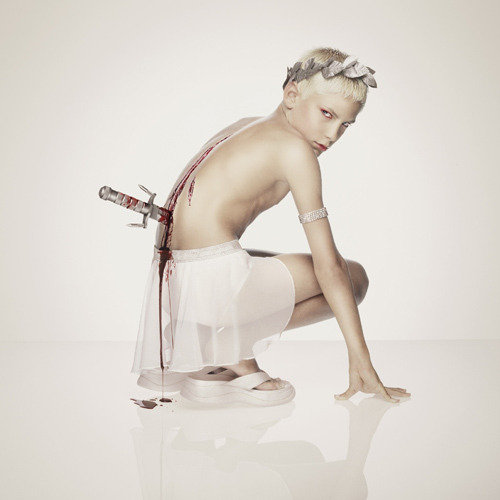Vanitas
dal 13/11/2012 al 9/12/2012
Segnalato da
Liet Heringa
Maarten van Kalsbeek
Hans Op de Beeck
Margriet Smulders
Richard Kuiper
Erwin Olaf
Persijn Broersen
Margriet Lucacs
Sabina Orudjeva
Larissa Buwalda
13/11/2012
Vanitas
Moscow Museum of Modern Art (Zurab Gallery), Moscow
Contemporary Reflections. A visual and a philosophical reflection on the Vanitas tradition in contemporary art. Works by Hans Op de Beeck, Erwin Olaf, Margriet Smulders and more.

curated by Sabina Orudjeva & Larissa Buwalda
This exhibition introduces both a visual and a philosophical reflection on the Vanitas tradition in contemporary art. Its curators aim to explain it a Russian audience and to show how the original messages and metaphors are interpreted in modern language by contemporary Dutch and Flemish artists. We revisit the Vanitas theme which evokes the same timeless questions so relevant to Russia as it is today.
The first independently produced still life paintings did not appear until the second half of the 16th century. Until then, still life was considered too insignificant to stand on its own merits in a single painting; parts of the tradition were included merely as decorative or symbolic elements in religious, mythological, or historical pictures.
The verse “Vanitas vanitatum et omnia vanitas” refers to the works of Dutch and Flemish still life painters of the 17th century. The region enjoyed a period of financial prosperity and became an area of intellectual and artistic liberalism.
* “Vanitas Vanitatum et Omnea Vanitas” lat. “Vanity of vanities, all is vanity”; Attributed to King Solomon, The Book of Ecclesiastes, Old Testament
Although by 1620 painters had explored every type of still-life subject that could be portrayed, it was not until 1650 that the term Vanitas was coined to describe an already well developed style. Still lives easily adopted moralistic narratives and Vanitas painting began to develop as a tradition in its own right. Indeed, each object painted by the artist of the time expressed a sense of the transience of worldly pleasures and the passage of time — scenes of human skulls, burnt candles, faded flowers, broken chalices, jewels, mirrors and books all alluded to the brevity and ephemeral nature of life. Precious objects in disarray expressed the futility of material wealth in the afterlife.
While still life paintings at that time were considered to be the lowest form of art, monarchs, aristocrats and merchants, nonetheless paid considerable sums for them. Many other collectors were those who simply aspired to a wealthy lifestyle and owned still-life paintings in lieu of the objects they might otherwise not afford: rare silver pitchers, Chinese porcelain and of course tulips — which in real life priced outside of the reach of most people.
The original Vanitas paintings were comprised of two main themes: one part pictured death and the other one life. This duality continues in contemporary art but the message is more subtle and psychoanalytical references to Eros and Thanatos recur throughout them. Artists even seem to have adopted the meticulousness of Sigmund Freud in his approach to the collection of dreams and nightmares, so masterfully demonstrated in the “Royal Blood” series by Erwin Olaf.
Here the vulnerability of beauty and the inevitability of the end is elegantly expressed in his gallery of portraits of royal deaths, beginning with Julius Caesar in 44 BC and ending with Princess Diana's passing in 1997.
Margriet Smulders explores the erotic nature of flowers, their almost dangerous, final instants of extreme beauty, inevitably followed by fading and then darkness, as if the theatre curtain is about to fall The sculptures of Liet Heringa and Maarten van Kalsbeek are constructed as bundles of memories and objects collected during their travels. Energetically pushing from the confinement of their original boundaries, their beautiful yet illogical still lives form a bridge between past and present.
Richard Kuiper, in his series “Dutch Still Life in Plastic”, remains faithful to the original symbols of the Vanitas tradition, but also constructs kitsch compositions from the mass-produced leftovers of the present era. And significantly, these plastic objects are likely to outlive all of our present day treasures.
Even if at first the Vanitas theme had either a moralizing intent or was painted for the pleasure of displaying the talent of the artist and the wealth of his patron, the message of beauty and its transience is clearly understood by today's viewer and once again expressed in the works of contemporary Dutch and Flemish artists.
List of Participating Artists.
Liet Heringa & Maarten van Kalsbeek — sculpture
Hans Op de Beeck — video-art, photography
Margriet Smulders — photography
Richard Kuiper — photography
Erwin Olaf — photography
Persijn Broersen & Margriet Lucacs
For additional informationa and photographs please contact Sabina Orudjeva: mob. 8 (985) 784-46-36, sabina@artisfoundation.com.
Opening november 14, 2012
Moscow Museum of Modern Art
9 Tverskoy boulevard Moscow



